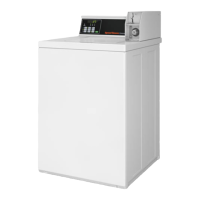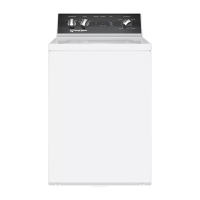
 Loading...
Loading...
Do you have a question about the ALLIANCE SWNNC2SP115TW02 and is the answer not in the manual?
| Brand | Alliance |
|---|---|
| Model | SWNNC2SP115TW02 |
| Voltage | 120V |
| Phase | Single Phase |
| Loading Type | Top Loading |
| Type | Washer |
| Control Type | Electronic |
Overview of the control interface and general programming capabilities of the topload washer.
Crucial information for safe installation, maintenance, and operation of the washer.
Overview of the advanced programmable computer control for the washer.
Definitions of key terms and abbreviations used in the manual.
How the washer recovers operation after a power interruption.
Methods for programming and data retrieval via external devices.
Details on cycle, temperature, and modifier selection pads.
Description of 7-segment digits and LEDs.
Explains the function of various LEDs indicating cycle status and selections.
Describes the use of digital displays for time, price, and error messages.
Initial state and readiness for operation.
Partial/additional vend modes and starting the cycle.
How the control indicates cycle progress and uses signals.
How opening the lid affects cycle operation.
How to modify cycles and set delayed starts.
Overflow, Lockout, and Shutdown modes.
Indicates an interrupted cycle due to power failure.
Control programming, audit information retrieval.
Testing, rapid advance, clear vend, communications.
Coin drop, start pulse, service door access.
Break-in alarm, OPL, Drop-Off, Out of Order modes.
Special vend pricing, low power/auto-shutdown.
Network node and error display modes.
Procedure to open the service door for programming and diagnostics.
Step-by-step guide to enter Manual Mode for programming and testing.
Overview of the five groups within Manual Mode.
List and description of all available programming options.
Setting vend prices for different cycles and temperatures.
Setting vend prices for different cycles and temperatures.
Adding prices to MEDIUM/HEAVY modifier keys.
Option to show decimal points in vend price display.
Configuring coin values for vend price calculation.
Configuring start pulse parameters for payment systems.
Programming control outputs for various reasons.
Defining when signals are active based on output type.
Setting the default cycle upon machine startup.
Configuring card reader display and audio signals.
Programming a unique number for wired/wireless communication.
Enabling or disabling specific error codes.
Setting the internal clock and daylight savings.
Enabling or disabling Special Vend 1 for specific days.
Enabling/disabling Special Vends 2, 3, and 4 for specific days.
Programming extra time for wash, rinse, or warm rinse.
Setting the default cycle modifier for Ready Mode.
Configuring options and adding time for MEDIUM/HEAVY modifiers.
Setting time for various steps in different cycles.
Enabling low power/shutdown for specific days of the week.
Setting time to store cycle info during power failure.
Enabling/disabling IR communication and manual modes.
Enabling/disabling rapid advance and manual diagnostics.
Enabling or disabling access to factory test mode.
Configuring lucky cycles and water temperature indicator.
Enabling/disabling display of close lid command.
Settings for push start and open lid display commands.
Overriding vend price and configuring OPL parameters.
Enabling delayed start and power saving for OPL mode.
Setting up drop-off mode for attendant use without vend.
Disabling machine use with an out-of-order message.
Methods to access and view audit feature data.
Steps to reset control to factory default settings.
Steps to enter and start diagnostic tests.
How to end diagnostic tests.
Testing software versions and door/vault switches.
Testing coin drops, vend connection, start pulse, and lid switch.
Testing fill/drain times and related operations.
Testing external outputs and water purge functionality.
Testing for water leaks and displaying water level sensor readings.
Displaying machine configuration values and dipswitch settings.
Steps to enter and exit the factory test mode.
Quick reference chart for factory test modes and displays.
Errors related to Infra-red and card reader communication.
Errors related to machine operation and payment systems.
Codes for common machine errors like communication or configuration issues.
Codes for errors like no communication, mismatches, or brownouts.
Codes for water leak and drain detection issues.
Codes for corrupted data, control configuration, and board communication.
Codes for drain, slow drain, and water leak detection issues.
Codes for overflow and pressure sensor issues.
Codes for motor thermal protection and drive/output board issues.
Details the default cycle steps and durations programmed at the factory.











